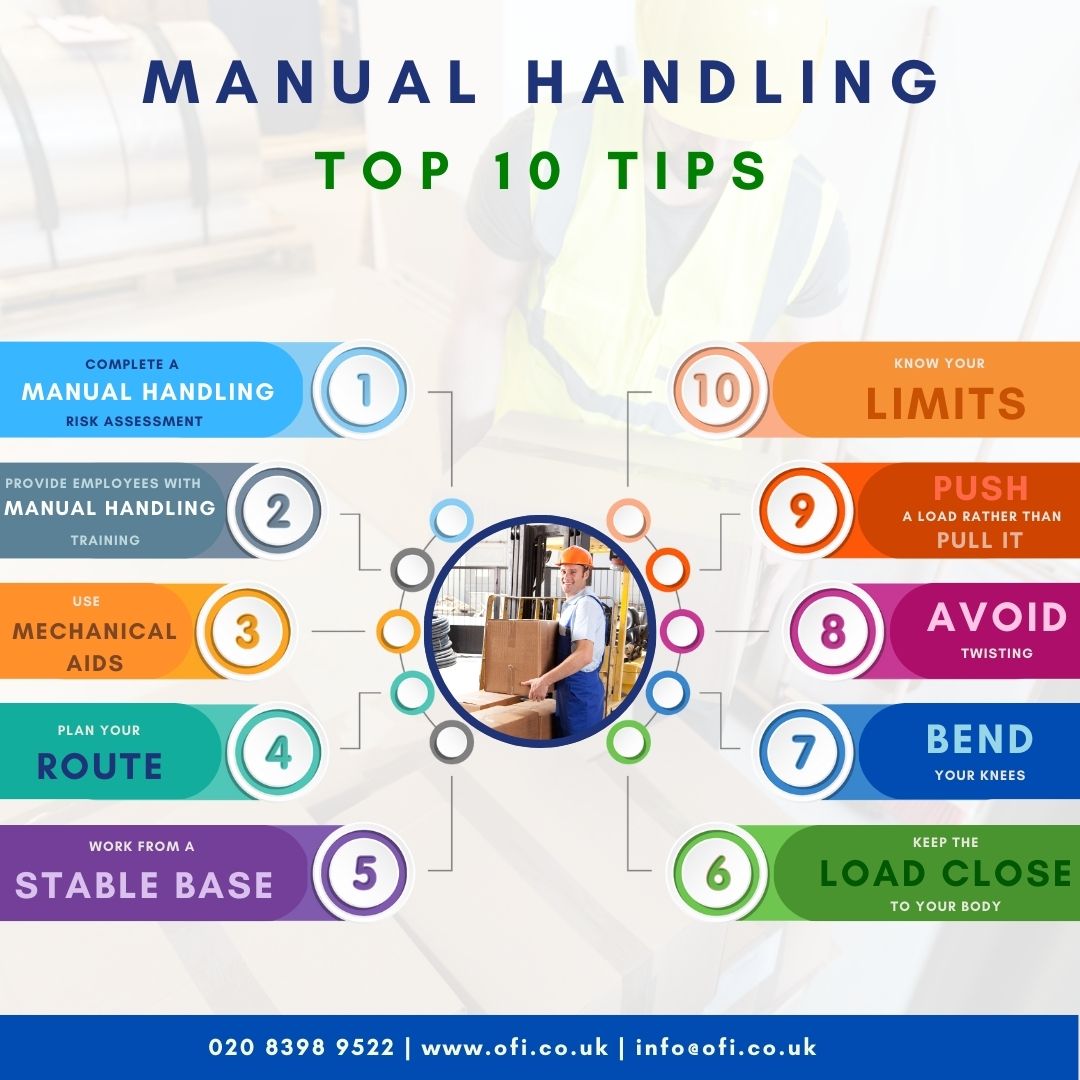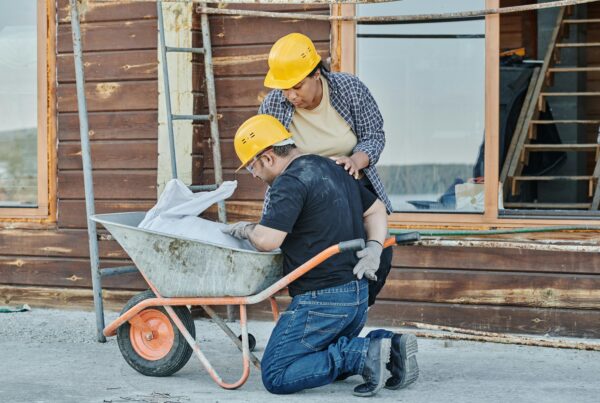Why Do We Need Risk Assessments and Practical Skills Training in Manual Handling in the Workplace?
Recently, Ben (a young worker, new to the construction industry) filed a claim against the Cardiff-based construction company with which he had been employed. In the first few days of Ben’s employment, he seriously strained his back whilst lifting and carrying heavy bricks from a pallet to a wheelbarrow in a yard outside one of the company’s storage depots. The injury occurred early in the morning, just a few days into his employment. The weather conditions were very poor; a cold wind blew, and torrential rain made the yard surface slippery underfoot. Ben had also come to work wearing his own trainers as he had not been supplied with (or advised to wear) any appropriate non-slip work footwear.
As soon as he arrived, Ben’s supervisor asked him to shift a large pile of bricks. Apart from suggesting it might be best if he wore protective gloves, he didn’t offer Ben any guidance or on-the-job safety training surrounding manual handling techniques he should employ to minimise the risk of injury. Because of the adverse weather conditions, after taking his supervisor’s instructions, Ben took it upon himself to try shifting a larger load of bricks in one go to try and speed up the task at hand. It hadn’t been explained that this might increase his risk of injury, even more so as he wasn’t using the correct manual handling techniques to minimise the strain being exerted on his back. In addition, nobody had explained to Ben how to assess the risk associated with increasing the load he was moving. Neither had he been made aware that he should exercise caution, as the poor weather conditions had made the road slippery underfoot. After about an hour, with the increased load in hand, his right foot slipped on the wet yard floor. The bricks went flying as he stumbled to the ground and felt an immediate searing pain in his low back which instantly immobilised him. The pain continued, and he found he couldn’t physically straighten up, so his supervisor had to send him home. Unfortunately, Ben had suffered a severe acute low back injury, including a partial tear to his low back muscles and nerve root involvement. It took several months for him to recover and be able to work again. His medical specialist told him that he would probably have long-term, recurring back problems as a result of the injury.
As a new employee at the construction company, Ben hadn’t been provided with any initial induction training in health and safety procedures, manual handling techniques, or risk assessment training. These forms of training would have taught him techniques to minimise the risk of injuring himself when lifting and moving objects whilst working. As a result, he severely injured himself. He took action against the company for negligence, successfully won his case, and the company had to pay out a hefty compensation.
Case Overview
This case highlights the importance of conducting a manual handling task risk assessment and giving employees proper manual handling training to prevent workplace injuries. Had the correct risk assessment procedures been followed, it would have been more than likely that this manual handling task would have been postponed due to the adverse weather conditions which heightened the risk level (including cold temperatures, howling wind, and driving rain which caused dangerous working conditions, including a wet, slippery floor). In any event, Ben should have received comprehensive training in manual handling techniques, as well as the correct personal protective equipment (PPE), including appropriate heavy-weight, non-slip construction footwear. This case highlights the importance of employers providing their employees with adequate supervisory support (risk assessment), as well as appropriate safety training relevant to the tasks in hand. This would have included a task/load/environment/individual capability risk assessment, as well as practical skills training in manual handling. Ben’s experience also highlights the importance of employers making sure their employees are equipped with the appropriate PPE to minimise the risk of injury.
For any organisation, the costs associated with manual handling injuries can be significant. These costs include the direct fee of the medical treatment required, time off work for the affected employee, and indirect costs like lost productivity and reduced morale. Implementing proper risk assessment and practical skills training in manual handling can help to reduce the risk of injury and the associated outlay it can entail.
What is manual handling?
- Manual handling means when an employee manually carries, transports, or manipulates a load from one place to another.
- It encompasses a variety of activities which range from lifting, lowering, pushing, pulling, carrying, using hand tools, operating machinery, cleaning, painting, packaging, and more.
- If any of these tasks are not completed properly, there is an associated risk of injury.
Why are safe lifting and manual handling practices important?
- Over a third of all workplace injuries are related to manual handling in some form, with over 33% of all work-based injuries in the UK accounting for musculoskeletal disorders which have been caused by manual handling injuries.
- Research has found that manual handling injuries are one of the most common causes of workplace injuries. Manual handling related musculoskeletal disorders like repetitive strain injuries and damage to the arms, legs, and joints account for a significant share of workers’ compensation claims in the UK.
- Manual handling that is repetitive or requires forces can cause wear and tear in the musculoskeletal system, damaging muscles, tendons, ligaments, bones, joints, nerves, or blood vessels. This can happen suddenly or result from accumulative practice, developing over longer periods.
- Unsafe manual handling techniques can lead to injuries and accidents that mainly affect the following three areas of the body:
- The neck and upper limbs – shoulders, arms, elbows, wrists, and fingers.
- The lower limbs – legs, knees, and ankles.
- The back – resulting in pain and injuries.Unsafe manual handling practices can greatly affect an employee’s ability to perform at work and home, significantly inhibiting their quality of life. Consequently, managing the risks and dangers associated with manual handling is extremely important.
The four determinants of injuries associated with lifting and manual handling:
The four factors associated with the risk of manual handling and lifting-related injuries include:
1. The Load:
The load being lifted or carried can increase or decrease the risk of injury that can be caused by manual handling. Unsafe lifting and handling practices can increase the physical demands of the task and make it more challenging to maintain proper body mechanics. This directly increases the risk of musculoskeletal injuries. Factors to keep in mind for safe manual handling and lifting practices include:
- Weight of the load:
If the object is too heavy for a worker, it will be difficult for them to carry and is more likely to cause injury. - Characteristics of the load:
o Awkwardly shaped objects are hard to grasp and slip easily.
o Loads containing liquids frequently shift their centre of balance, making them extremely difficult to carry.
o Items with sharp edges can cause harm if they collide with other workers or objects.
o Large loads require the worker to use a firm grip, making it difficult to produce adequate force to lift them. - Location of the load:
Objects placed in awkward locations will affect the person’s ability to push, pull, lift, or carry them. For example, an object kept at a height that is difficult to reach increases the worker’s vulnerability to injury, making it much more likely that they will hurt themselves.
2. The Work:
The nature of the industry and the task at hand may make manual handling injuries more likely. For example, the risk of a construction worker or a worker at a demolition site experiencing a manual handling-related injury is higher than someone working in a corporate office.
Some factors to keep in mind in this context include:
• The duration and frequency of the task:
- If the task is repetitive or of long duration, it can become extremely demanding for a worker. In this case, careful management to provide workers with sufficient rest and recovery time becomes essential.
• Awkward postures and movements:
- This includes working in a fixed posture over an extended period and performing tasks in awkward positions. For example, crouching while performing maintenance work on machinery or twisting whilst picking items off a conveyor belt.
3. The Environment:
- A poorly designed workspace, faulty planning, and cramped areas can all cause potential collisions while carrying loads.
- Moreover, exposure to hot and cold temperatures can lead to exhaustion of workers and may also affect their ability to grip, making them more prone to injury.
- Therefore, by designing tasks, equipment, and workspaces to fit the physical capability of the workers, it is possible to lower the risk of injury and improve the overall efficiency and safety of the working environment.
- Employers are responsible for providing ergonomic interventions like adjusting the height of work surfaces, providing mechanical aids to assist with heavy lifting, and holding training to develop safe lifting techniques that reduce the risk of injuries.
4. The Person:
- Certain characteristics of the individual employee can influence the risk of injuries. E.g., familiarity with the job and experience doing a certain type of work, age, fitness levels, and training completed.
The checklist for safe lifting:
Safe lifting techniques require you to ask yourself two fundamental questions to prevent an injury. These include:
- What should I take into account while lifting?
- Before lifting, it’s important to look at one’s training, individual capability, the load that needs moving, and the overall working conditions.
- What can I do to reduce my risk of getting injured?
- As far as possible, avoid twisting, stooping, and reaching to floor level or above shoulder height to lift objects (especially heavy loads).
- Determine how to minimise the carrying distance – ask for help as and when needed.
- In case of heavier loads, if possible, break the load down into smaller, lighter components that are easier to carry.
What are the characteristics of a good lifting and handling technique?
By following the principles of good lifting and handling techniques, you can significantly reduce the risk of injury and perform manual handling tasks safely.

11 top manual handling tips:
1. Plan the lift:
- Remember, there is a difference between what you can lift and what you can lift safely. When in doubt, seek advice or ask for help.
- Before lifting an object, plan the route and clear all obstacles that might be in the way.
- Ensure a good grip using both hands. Make the load as stable and secure as possible.
2. Keep the load close to your body:
- Keeping the heaviest side of the load close to your body reduces the strain on your muscles and helps maintain a good balance.
- If you can’t get close to the load, you can try sliding it towards your body before you attempt to lift it.
3. Use your legs:
- Try to lift with your legs, not your back.
- Bend your knees and keep your back straight as you lift to reduce the strain on your back muscles.
- Avoid flexing your back while lifting. This usually happens if you begin to straighten your legs before you start to raise the load off the ground.
4. Avoid twisting:
- Instead of twisting while lifting or carrying an object, turn your feet to change direction.
- Keep your shoulders level and face in the same direction as your hips.
- Look ahead and not down at the load once you develop a secure hold.
5. Avoid stretching:
- Instead of reaching out and unnecessarily stretching, move closer to the object or use a mechanical aid to help move it.
6. Adopt a stable position:
- Keep your feet apart (with one leg in front of the other) to increase stability.
- Use proper body mechanics to lift the object – your back must be straight and your knees bent whenever you’re lifting anything.
- Instability can be caused by tight clothing or unsuitable footwear – make sure to avoid these and dress with practicality in mind.
7. Move smoothly:
- Do not make jerky, abrupt movements, as this can make it hard to maintain control, increasing your risk of injury.
- If necessary, put the weight down and adjust it before trying again.
8. Take breaks:
- Whilst repeatedly handling heavy objects, taking breaks to rest and stretch is extremely important.
9. Use equipment:
- As and when needed, use gloves, back supports, and other gear to reduce the risk of injury.
- If available, you can also use mechanical aids like trolleys, dollies, and forklift trucks to reduce the risk of injury (although you must receive the appropriate training in these beforehand).
10. Report any injuries:
- If you experience pain or discomfort while lifting and handling, report it to your supervisor and seek medical attention.
11. Follow safety guidelines and seek training:
- Following safety guidelines and procedures is extremely important while lifting and manual handling.
- If you are unsure about performing manual handling tasks safely, seek training from a supervisor or a qualified trainer.
Best practices go a long way
According to a research study published by the National Library of Medicine, in the UK, musculoskeletal disorders gained as a result of unsafe manual handling practices at work resulted in an average of 15 days off work per injury every year.
Lifting and manual handling are daily tasks in many workplaces, and it’s vital to follow best practices to ensure your employees’ safety. Safety in the workplace should never be compromised – it is essential to protect both yourself and your co-workers. It’s a crucial aspect of many different types of jobs, and employers are responsible for ensuring their employees can carry out their work safely, without harm. Employers should also intervene to develop their employees’ capabilities to reduce the risk of injury and the costs that this can cause.
It’s important that employees are also proactive in seeking training and assistance in following safe lifting and handling practices to protect themselves and their colleagues. By working together, employers and employees can create a safe and healthy work environment that promotes wellbeing for all.
References
- Good handling technique – Health and Safety Executive.
- Risk at Work – Manual Handling – UK Health and Safety Executive.
- What is Manual Handling and why is it important? – Rehab Management.
- Proper Lifting Techniques – Mayo Clinic.
- Manual Handling Injuries and What You Can Do to Prevent Them – BCF Group.
- Health and Safety Training – Workplace Safety and Insurance Board, Ontario, Canada.
- Examination of Postures and Frequency of Musculoskeletal Disorders Among Manual Workers in Calcutta, India – National Library of Medicine.
- What are the Consequences of Manual Handling? – CPD Online.
Please note, these are external links away from the OFI website. We are not responsible for the content of external websites.








